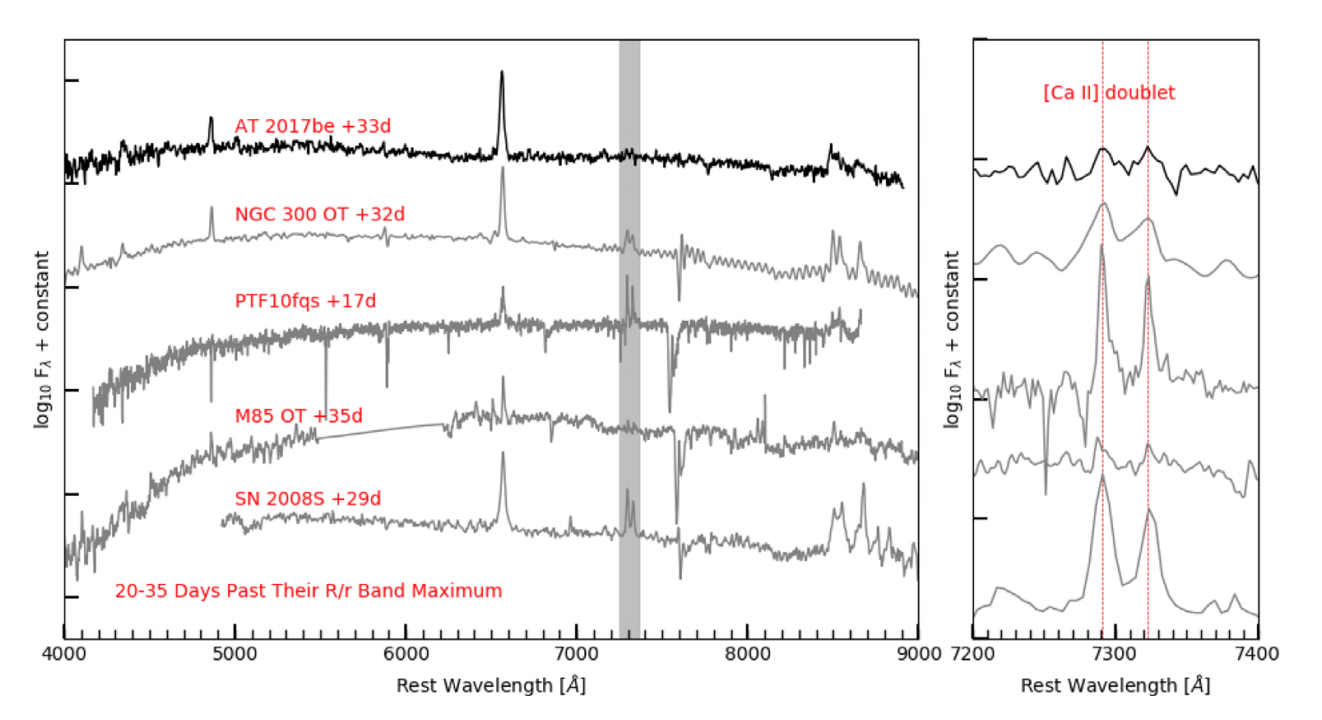Padova-Asiago Supernova Group
Intermediate-Luminosity Red Transients (ILRTs)
These transients have light curves similar to those of subluminous Type II-L SNe (e.g. SN 2008S and NGC300-2008OT1) or Type II-P SNe (e.g. M85-2006OT1 and PTF10fqs), and – when observed – the late time decline is consistent with that of the 56Co decay. Their spectra are initially quite blue, but become redder with time. They show prominent H lines in emission (similar to those of other types of H-rich transients) and Ca II lines, with the typical [Ca II] 7291, 7323 Å (Fig. 1) being prominent. This doublet, which is rarely observed in SN impostors or other Gap Transients, is always detected in ILRTs. In quiescence, the moderately massive progenitors of ILRTs (8-12 solar masses), are usually detected in the mid-IR domain, as they are enshrouded by dusty cocoons (Fig. 2).

Fig. 1 Spectral omparison of ILRTs at similar phases. The blow-up on the right shows the region between 720 and 740 nm, including the [Ca II] 7291, 7323 A doublet (Figure from Cai et al. 2018, MNRAS, 480, 3424).
ILRTs are proposed to be electron-capture supernovae from Super-Asymptotic Giant Branch (S-AGB) stars (e.g., Botticella et al. 2009, MNRAS, 398, 1041; Pumo et al. 2009, ApJ, 705, L138; Pastorello et al. 2007, Nature, 449,1; Thompson et al. 2009, ApJ, 705, 1364 ). Although this interpretation has been disputed (e.g. Smith et al. 2011, MNRAS, 415, 773), growing observational arguments support the terminal supernova explosion scenario for ILRTs. In particular, mid-IR images of the ILRT sites taken several years after the outburts show some residual flux, but these residual sources are much fainter than that of the quiescent progenitors (Adams et al. 2016, MNRAS, 460, 1645).
ILRTs are the subject of the PhD Thesis of Giorgio Valerin, which is work in progress.


Fig. 2 Archive space telescopes images of ILRT NGC300-2008OT1 region. The progenitor star, embedded in a dusty environment, is not detected in the HTS/ACS optical images (left), but is clearly visible in the mid-infrared domain (right). Credits: Berger et al. 2009, ApJ, 699, 1850.
Leading researchers: G. Valerin, Y.-Z. Cai, A. Pastorello.
Collaborators: M. T. Botticella, M. L. Pumo (UniPa), N. Elias-Rosa, R. Kotak, M. Fraser, M. Stritzinger, A. Reguitti, G. Pignata, P. A. Mazzali.
Publications:
- Cai 2019, PhD Thesis, Padova University
- Valerin 2019, MSci Thesis, Padova University
- Cai et al. 2021, A&A, 654, A157
- Cai et al. 2018, 480, 3424
- Pastorello et al. 2011, AN, 332, 266
- Patat et al. 2011, A&A, 510, 108
- Pumo et al. 2009, ApJ, 705, L138
- Botticella et al. 2009, MNRAS, 398, 1041
- Pastorello et al. 2007, Nature, 449, E1